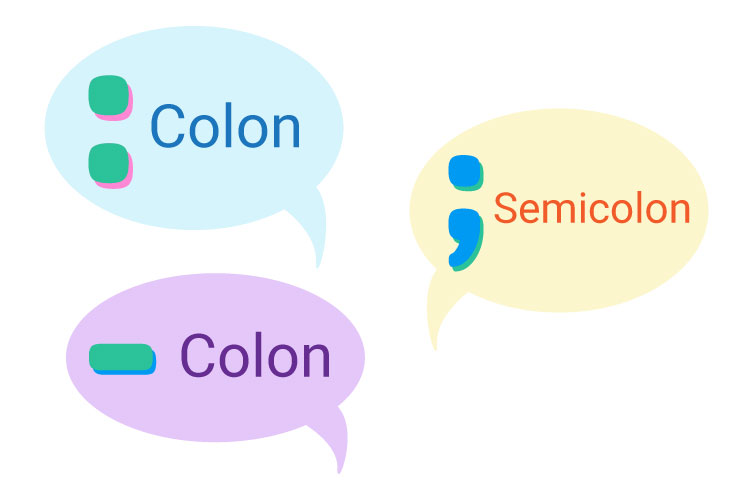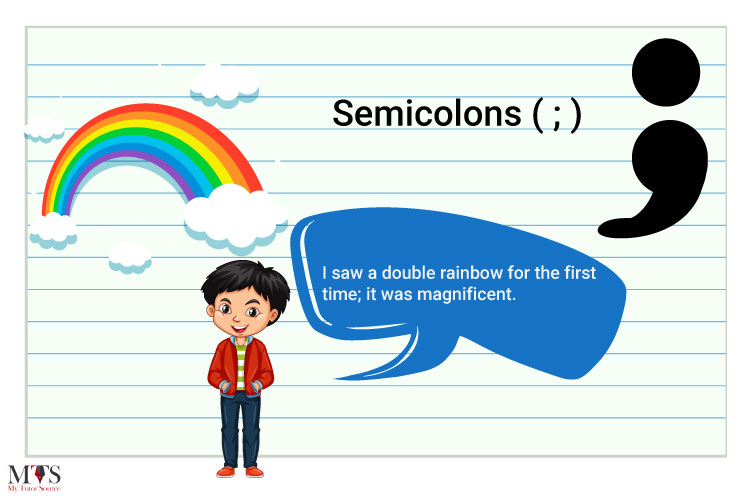

Punctuation plays a vital role in the English language as they have a huge impact on the context and meaning of the text. Colon, semicolons, and dashes are the punctuation marks that complicate people the most. Their usage is a bit complex and has various rules and regulations that we need to follow.
Colon explains, draws attention, introduces, or joins ideas together.
A semicolon creates separation, more than a comma but less than a period, between two thoughts.
Whereas dashes are used to indicate a pause or range, commonly used to separate groups of words and not parts of words as hyphens would.
Let’s get into the details for each to understand better the role, usage/placement, and specific rules about these punctuations.
Colon is a punctuation mark consisting of two equally placed dots above one another along the same vertical line.
Colons can be placed in the text before announcing, introducing, or directing attention to noun/noun phrases, quotations, lists, examples, or explanations.
It is also used in writing time to separate hours from minutes, in various citations (denoting paragraph and verse number), and salutations used in formal/professional documentation or letters.

Let’s check out a few examples to avoid the colon’s misuse in your writing.
You can use the colon to draw attention to a wide range of things in your writing. Below are a few categories where you can use a colon to draw an introduction or direct attention towards something.
Lists/Series example:
We will be discussing the use of a few punctuation marks: colon, semicolon, and dashes.
Or
Here’s a list of my favorite fruits: Peaches, strawberries, avocados, bananas, mangoes, watermelon/melon/cantaloupe.
Noun/Noun Phrase Example:
Life taught me three great lessons: Preservation, humility, and authenticity towards who you are.
Quotation Example:
René Descartes said:
“I think, therefore I am.”
Explanation Example:
You will notice that there are a few disadvantages of working in a corporate environment:
Less Agency
Office Politics
Monotonous Routine
Elevated Competition
Less Personal Time for Hobbies
Colons can be used to join two sentences, given that both the sentences are complete in themselves and the second sentence adds contexts to the first one.
Example:
Life is hard: The key is to be persistent.
We can use a colon to differentiate different units of time.
Example: 10:15 pm or 10:00:00
Colona can be used to denote different ratios.
Example: Take a 4:3 volume NaCl Solution.
They can also be used when separating different items in citations.
Example: (Matthew 2:24)
Colons are also used to separate subtitles from the main title.
Example: Humanistic Psychology: The Great Paradigm Shift
The salutations within formal letters can be followed by a colon directly.
Example: Dear hiring manager: Please find my resume enclosed with this cover letter.
1. Don’t use a colon between a preposition and its object.
My favorite pasta is made with: fettuccine pasta, heavy cream, cheese, milk, garlic, onion, olive oil, and grilled chicken.
This sentence is incorrect, as the colon here is unnecessary.
2. Never use a colon between a verb and its object or complement.
The best kind of people are: those who are humble.
This is also incorrect as, the sentence is being broken down for no reason at all.
3. Avoid using a colon after “including,” “such as,”, “especially,” and other similar phrases.
There are many different kinds of writings: story writing, narrative writing, essay writing, copywriting, etc.
If you want to know whether you placed the colon correctly in your text, ask yourself if the material preceding the colon stands on its own? Because if not, then you have placed a colon incorrectly.
Various citation styles (APA, Michigan, Chicago, MLA, etc.) have different rules of capitalization of the first letter after the colon. So make sure you go through the citation manual beforehand to be more precise.
Usually, the best rule is to capitalize the first letter after a colon only if the two thoughts are complete sentences on their own. However, if the thoughts following the clause are dependent clauses, it’s better not to capitalize the first letter.
Examples:
These movies had one common theme: Rise of the evil and their battle with good forces. (Correct)
The list of ingredients to make tea include: tea leaves, milk, sugar, and cardamom.
A semicolon is used to separate two independent clauses similar in context or thought. A semicolon is one of the least understood punctuations in the English language. When a semicolon is used to join two thoughts, they are given the same rank and importance. A semicolon is also used to separate items in a list, especially if the list already consists of commas.

A good way to remember the purpose of a semicolon is to look at how it is symbolized. It is a comma with a period placed above it, which creates a pause that is greater than a comma but less than a period.
Here are a few examples of how a semicolon is used:
1. To separate items in a list:
When you have a few items in a list, and they have more than one word in them separated by commas, it can get a little confusing when you separate these items with a comma.
For example:
Bitter, sweet grapefruit, tangy tangerines, citrusy, juicy oranges, mandarin oranges.
The commas separating the different items are not serving their purpose.
However, if we use semicolons, it would make more sense to the reader.
For example:
Bitter, sweet grapefruit; tangy tangerines; citrusy, juicy oranges; mandarin oranges.
This way, the readers get more visual cues to identify and differentiate individual items in the list and know which terms go together in one item.
2. To join two sentences:
Semicolons join two independent clauses. Independent clauses are complete sentences that stand as a whole on their own.
So when we join two independent clauses together with a semicolon, it would create a pause between two like a period would.
But since it’s a semicolon, we know that these independent clauses are linked together and reflect the same ideas, giving more clarity of the independence of two sentences, unlike a comma.
For example:
I went to the mall today. I bought a lot of clothing items. Sweaters, boots, hoodies, jackets, scarves were on sale.
So, where would we place our semicolon?
The three sentences are short and make the text look choppy and abrupt. But if we join the two of them with a semicolon, it would eliminate the choppiness.
Moreover, it will also show that the two clauses joined together by a semicolon are related.
For example:
I went to the mall today. I bought a lot of clothing items; sweaters, boots, hoodies, jackets, scarves, were on sale.
Using the semicolon in this place tells us that the reason I bought all these clothing items was because they were on sale.
When you join two independent clauses with a semicolon, always delete the conjunction holding the two clauses together.
For example:
I saw a double rainbow for the first time, and it was magnificent.
When joined by semicolons, would become:
I saw a double rainbow for the first time; it was magnificent.
Conjunctive adverbs connect two independent clauses with a conjunctive adverbial modifier. The common conjunctive adverbs are; moreover, nevertheless, however, otherwise, therefore, then, finally, likewise, and consequently.
So when we use conjunctive adverbs to link two sentences, we need to make sure that we place a semicolon before the conjunctive adverb (or after the first clause).
For example:
I was running late; therefore, I took the shorter route to work.
Mandy didn’t do her homework; moreover, she tried to bunk the class.
Dashes are the least used punctuation in the English language. They are used to emphasize a certain part of the sentence. Dashes need to be used with caution because overdoing them can make your text appear very choppy and hard to read.
However, we need to clarify that hyphens (-) are different from dashes, so you don’t get confused. Hyphens are used to link two words together, like well-informed, e-mail, etc.

The main idea behind a dash is to emphasize something followed by it, unlike parenthesis, which tells the reader that emphasis on the information between parentheses is not as important. However, there are certainly other uses for dashes as well.
They are as follows:
When you add phrases to a sentence to clarify your thought or provide additional information but not necessarily explain the meaning of the sentence, you can use a dash to link it with the sentence.
For example:
Depression can cause anhedonia – making the simplest of the tasks unpleasant – even the ones you enjoyed the most.
When you transcribe a speech or conversation, you can use “–” to indicate the pause in the dialogue.
For example:
I – I am not sure. What do you mean?
Dashes can add a dramatic effect to your writing. You can use them to highlight something important at the beginning, end, or middle of a sentence.
For example:
Finally, after years of introspection, he found his passion – writing!
Positive Psychology – The art of practicing mindfulness to manifest positive outcomes.
You can use dashes to highlight the introduction or conclusion to your sentences.
For example:
Depression, anxiety, and stress – The dilemma of social isolation in Covid-19.
We need to pay special attention to what we put out in the universe – You reap what you sow.
Remember a few important rules when using dashes:
1. When your sentence is resumed after the dash, make sure you use another dash instead of a comma.
For example:
The EdTech tools needed to ensure proper learning in the classroom – electronic devices, stable internet, and open access libraries – should be covered by the institution.
2. Never use other punctuations with the dashes.
For example:
The two years Masters, – from Yale University – was the best thing that happened to me.
3. It would be best to mark dashes before and after your list has ended.
For example:
The three main issues – poverty, illiteracy, and hunger – need to be eliminated to make the world a better place.
Colons, semicolons, and dashes – although the least used punctuation marks – do make a great impact in your writing. They clarify, they emphasize and add a dramatic effect to your writing; making it easier for the reader to understand the tone of your writing.
However, when used incorrectly can cause the totally opposite effect, making it hard for the reader to comb through abrupt breaks and cluttered sentences.
Using correct pronunciation is very important, as it can make or break the impact your writing could have on the reader.
If you struggle with using correct punctuation, don’t fret! Our expert English tutors got you covered. They can teach you how to learn and remember the rules of English Grammar and punctuation in a way that you will never make a mistake again.